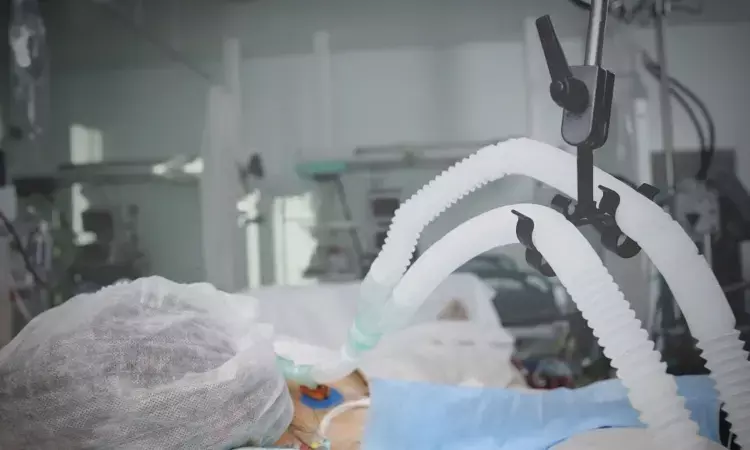- Home
- Medical news & Guidelines
- Anesthesiology
- Cardiology and CTVS
- Critical Care
- Dentistry
- Dermatology
- Diabetes and Endocrinology
- ENT
- Gastroenterology
- Medicine
- Nephrology
- Neurology
- Obstretics-Gynaecology
- Oncology
- Ophthalmology
- Orthopaedics
- Pediatrics-Neonatology
- Psychiatry
- Pulmonology
- Radiology
- Surgery
- Urology
- Laboratory Medicine
- Diet
- Nursing
- Paramedical
- Physiotherapy
- Health news
- Fact Check
- Bone Health Fact Check
- Brain Health Fact Check
- Cancer Related Fact Check
- Child Care Fact Check
- Dental and oral health fact check
- Diabetes and metabolic health fact check
- Diet and Nutrition Fact Check
- Eye and ENT Care Fact Check
- Fitness fact check
- Gut health fact check
- Heart health fact check
- Kidney health fact check
- Medical education fact check
- Men's health fact check
- Respiratory fact check
- Skin and hair care fact check
- Vaccine and Immunization fact check
- Women's health fact check
- AYUSH
- State News
- Andaman and Nicobar Islands
- Andhra Pradesh
- Arunachal Pradesh
- Assam
- Bihar
- Chandigarh
- Chattisgarh
- Dadra and Nagar Haveli
- Daman and Diu
- Delhi
- Goa
- Gujarat
- Haryana
- Himachal Pradesh
- Jammu & Kashmir
- Jharkhand
- Karnataka
- Kerala
- Ladakh
- Lakshadweep
- Madhya Pradesh
- Maharashtra
- Manipur
- Meghalaya
- Mizoram
- Nagaland
- Odisha
- Puducherry
- Punjab
- Rajasthan
- Sikkim
- Tamil Nadu
- Telangana
- Tripura
- Uttar Pradesh
- Uttrakhand
- West Bengal
- Medical Education
- Industry
Amikacin protects mechanically ventilated patients from ventilator-associated pneumonia

Usually occurring 48 hours or more after mechanical breathing via a tracheostomy or endotracheal tube, ventilator-associated pneumonia (VAP) is linked to increased antibiotic use, resistance, longer stays in the intensive care unit (ICU), and higher fatality rates. After seven days of ventilation, the peak incidence appears, providing a treatment window for reducing the likelihood of VAP. Nine studies with moderate sample sizes were meta-analyzed to show that VAP prophylaxis was effective. Inhaled amikacin's preventive ability to reduce VAP incidence in critically sick patients ventilated for at least 72 hours was examined in the AMIKINHAL study, which compared it to a placebo to prevent VAP. During a 28-day follow-up, the multicenter, double-blind, randomised study with 847 individuals showed a substantial decrease in the incidence of VAP in the amikacin group as compared to the placebo group. Furthermore, the amikacin group had significantly fewer ventilator-associated problems due to infections. One weakness of the study was that it lacked the capacity to evaluate the outcomes of death and length of ICU stay. According to the experiment, individuals with VAP may benefit from a further three-day regimen of inhaled amikacin.
850 patients from 19 intensive care units in France were included in the trial; 417 patients received amikacin after three patients withdrew their permission, and 430 received a placebo. Nebulized sodium chloride or amikacin was given to patients at random, with participants and treating doctors kept in the dark. 78% of patients were taking systemic antibiotics at the time of randomization. Three hundred and thirty-seven patients (81%) in the amikacin group and three hundred and thirty-five patients (83%) in the sodium chloride group completed all three planned nebulizations. The development of VAP post-nebulization was the main result, while the duration of stay, mortality, median number of days on mechanical ventilation, events related to the ventilator, and days of antibiotic use were important secondary outcomes. After 28 days, 62 patients (15%) in the amikacin group and 95 patients (22%) in the placebo group had ventilator-associated pneumonia (difference in limited mean survival time to ventilator-associated pneumonia, 1.5 days; 95% Confidence Interval [CI], 0.6 to 2.5; p=0.004) that had developed. Additionally, 111 patients (26%) in the placebo group and 74 patients (18%) in the amikacin group had a ventilator-associated problem attributable to an infection (hazard ratio, 0.66; 95% CI, 0.50 to 0.89). Four patients (0.9%) in the placebo group and seven patients (1.7%) in the amikacin group had trial-related major side events. With regard to the possible preventative use of inhaled antibiotics in critically sick patients, this investigator-initiated study offers crucial information.
The researchers concluded that the use of inhaled amikacin reduced ventilator-associated pneumonia (VAP) in patients on mechanical ventilation for more than three days.Amikacin inhalation was linked to a decrease in the incidence of VAP throughout a 28-day period of observation.
Reference –
Ehrmann, S., Barbier, F., Demiselle, J., Quenot, J.-P., Herbrecht, J.-E., Roux, D., Lacherade, J.-C., Landais, M., Seguin, P., Schnell, D., Veinstein, A., Gouin, P., Lasocki, S., Lu, Q., Beduneau, G., Ferrandiere, M., Plantefève, G., Dahyot-Fizelier, C., Chebib, N., … Tavernier, E. (2023). Inhaled amikacin to prevent ventilator-associated pneumonia. The New England Journal of Medicine, 389(22), 2052–2062. https://doi.org/10.1056/nejmoa2310307
MBBS, MD (Anaesthesiology), FNB (Cardiac Anaesthesiology)
Dr Monish Raut is a practicing Cardiac Anesthesiologist. He completed his MBBS at Government Medical College, Nagpur, and pursued his MD in Anesthesiology at BJ Medical College, Pune. Further specializing in Cardiac Anesthesiology, Dr Raut earned his FNB in Cardiac Anesthesiology from Sir Ganga Ram Hospital, Delhi.
Dr Kamal Kant Kohli-MBBS, DTCD- a chest specialist with more than 30 years of practice and a flair for writing clinical articles, Dr Kamal Kant Kohli joined Medical Dialogues as a Chief Editor of Medical News. Besides writing articles, as an editor, he proofreads and verifies all the medical content published on Medical Dialogues including those coming from journals, studies,medical conferences,guidelines etc. Email: drkohli@medicaldialogues.in. Contact no. 011-43720751


